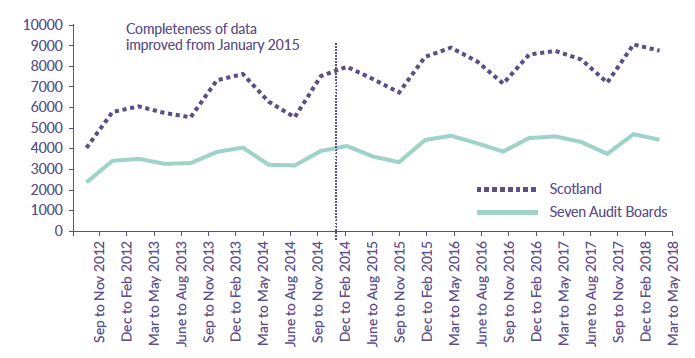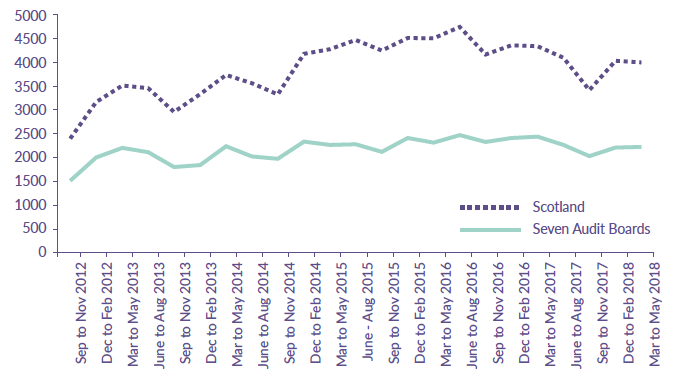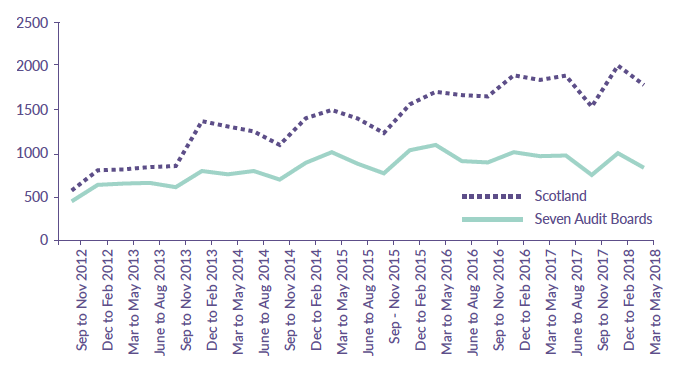Rejected referrals to child and adolescent mental health services: audit
A qualitative and quantitative audit of rejected referrals to Child and Adolescent Mental Health Services (CAMHS).
Background To Research
In 2017 the Scottish Government published its Mental Health Strategy 2017-27. [1] Action 18 of the strategy committed the Scottish Government to “Commission an audit of CAMHS rejected referrals, and act upon its findings.” This research was commissioned in fulfilment of the first part of that action.
Scottish Government asked SAMH (Scottish Association for Mental Health) and Information Services Division ( ISD) Scotland, of NHS National Services Scotland to carry out qualitative and quantitative work to examine referrals to CAMHS which were rejected.
The framework for Child and Adolescent Mental Health Services ( CAMHS) in Scotland was most recently set out in Children and Young People’s Mental Health: A Framework for Promotion, Prevention and Care. [2] This reiterated the tiered framework first set out in 1995, before NHS services were devolved to Scotland. [3] A Framework for Promotion, Prevention and Care explains the tiered approach to CAMHS as follows.
“Child and adolescent mental health services ( CAMHS) is sometimes used to embrace the range of services across agencies that contribute to the mental health and care of children and young people. These are sometimes referred to as universal or Tier 1 services and include those services whose primary function is not mental health care, such as general practice, schools and social services… Specialist CAMHS are sometimes referred to as Tier 2, 3 or 4 services. They include generic multi-discipline teams, single professional teams, targeted teams (e.g. for looked after children and young people), “outposters” (i.e. people who are CAMH-trained and employed, but who work in non- CAMHS settings), and specialist care teams (e.g. day patient, inpatient, intensive outreach).”
Information Services Division ( ISD) Scotland states that the NHS in Scotland,
“provides mental health services for children and young people with a wide range of mental health conditions including Attention Deficit Hyperactivity Disorder ( ADHD), anxiety, behaviour problems, depression and early onset psychosis. This treatment is provided through Child and Adolescent Mental Health ( CAMH) services. These services, which are mainly outpatient and community based, are provided by a range of staff including psychiatrists, mental health nurses, clinical psychologists, child psychotherapists, occupational therapists and other allied health professionals.” [4]
The Scottish Government has set a standard for the NHS in Scotland from December 2014 for a maximum waiting time of 18 weeks from a patient’s referral to treatment for specialist CAMHS. Since this target was set, ISD Scotland has published quarterly updates on waiting times for CAMHS. These figures include data on the number of “rejected referrals”: that is, referrals that are made to CAMHS Tier 2, 3 or 4 services which are not accepted by the service. This information has been published quarterly since August 2012.
There has been concern from a range of people and organisations about the number of rejected referrals to CAMHS, and about what happens to the children and young people whose referral is not accepted.
Across Scotland, referrals to CAMHS have been increasing. Figure 1 illustrates this point and draws out the seven Health Boards participating in the quantitative element of this research, called Audit Boards for the remainder of the report. In 2017, 33,309 referrals were received. [5] Although the data on CAMHS referrals was collected from 2012, it was not until January 2015 that all NHS Boards were able to submit complete data of sufficient quality. There were around 7,500 referrals during the quarter ending February 2015 compared to 9,000 for the same quarter in 2018, which is around a 20% increase over three years. It can also be seen that there is a seasonal pattern each year, with referrals to CAMHS during September to November at the lowest and March to May sees the higher number of referrals.
Figure 1: Number of children and young people referred to CAMHS by quarter

Source: ISD CAMHS Waiting Times
For the year ending February 2018, 15,864 children and young people started their treatment across Scotland (figure 2). This is a slight reduction in those starting treatment when compared with the previous two years, with 17,745 for year ending February 2017 and 17,476 for year ending February 2016.
Figure 2: Number of children and young people seen by CAMHS by quarter

Source: ISD CAMHS Waiting Times
In 2017, 7,266 referrals to CAMHS were rejected across Scotland.
The most recent statistics, published in June 2018, show that for the quarter ending March 2018, one in five (20%) of all referrals to CAMHS were rejected. Although the overall number of referrals to CAMHS is increasing (Figure 1), the rejected referral rate has been broadly stable at one in five since December 2016 (Figure 3 shows the actual number of rejected referrals for each quarter). For comparison, the most recent statistics for psychological therapies referrals show a rejected referral rate of 5.7%. [7] During the period the audit was carried out (February 2018), across all Health Boards, 1 in 5 referrals (21%) to CAMHS were rejected this compares with 19% for the Audit Boards.
Figure 3: Number of CAMHS rejected referrals by quarter

Source: ISD CAMHS Waiting Times
Contact
An easy-read version is available on request from MentalHealthStrategyandCoordinationUnit@gov.scot.
There is a problem
Thanks for your feedback